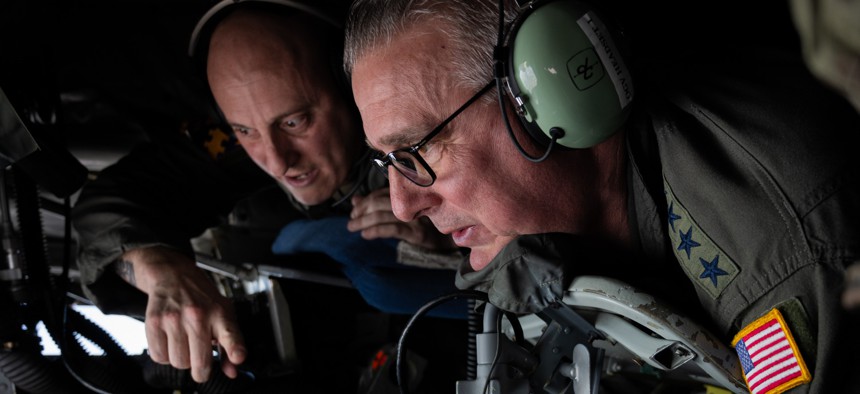
Gen. Mike Minihan, Air Mobility Command commander, listens to 108th Air Refueling Squadron boom operator Technical Sgt. Ryan Mullins give instruction on how to operate the boom of a KC-135 Stratotanker during an orientation flight, March 2, 2024. U.S. Air Force / Staff Sgt. Aaron Rodriguez
Air Mobility commander pushes for connectivity for outdated mobility fleet
Minihan said he wishes his planes were better able to communicate as the command delivers aid to Gaza.
The Air Force’s mobility fleet needs to be better connected to the joint force if it’s going to be ready to fight in the Pacific, according to Air Mobility Command’s leader.
“We have more connectivity in our cars and on our cell phones than we do in the forward edge of the mobility platforms right now—and we have got to aggressively depart from that,” Gen. Mike Minihan said during Defense One’s State of Defense series.
The general, who has about five months left in his term, has been pushing to modernize the fleet, and earlier this year announced his goal to get 25% of the mobility fleet connected by 2025, which amounts to about 250 airplanes.
“We are condemned right now to essentially have to squeeze a trigger on a microphone to get the situational awareness we need, and I'm convinced that there is capabilities now that exist that we can purchase for a very, very low price, and that we can instantly boost our ability to support the joint team,” Minihan said.
This would entail “roll-on capability” like a small kit or palette that AMC crews can plug into for “line of sight, beyond line of sight, secure communications” and join the DAF Battle Network, Minihan said, also known as the Air Force’s contribution to the Pentagon’s JADC2 effort.
Improved connectivity would help the planes and crew currently delivering humanitarian aid to Gaza, he said. The command’s C-130 and C-17 aircraft have been airdropping food and water to Gaza since the beginning of March.
“As I work the scenes of the command relationships, as I understand the threat, and as I integrate with a joint team, as I integrate with the Jordanian [Air Force] and other partners that are doing the operations there, it would be wonderful if I had more connectivity,” he said. This drive serves the highest end of conflict, but it also serves the highest end of humanitarian support which we're experiencing right now.”
Minihan has been vocal about the state of the mobility fleet and how his airlifters and tankers are in “generation 2.5,” while fighters and bombers are on fifth- and sixth-generations. “It's not asking too much” to get the same connectivity that the rest of the force has, he said.
And while AMC has been successful in operations over the past few years—including the Afghanistan evacuation, military aid deliveries to Ukraine, and airdrops in Gaza—all of that “pales in comparison to what will happen if we have to fight in the Pacific.”
“I want to put a team on the field that's ready to handle the full spectrum of operations that may come our way, and it starts with connectivity,” Minihan said.
Minihan didn’t say which mobility aircraft will be connected first, but said they’re going to address the “fleet in total,” adding that some aircraft have better connectivity than others, like comparing H model vs J model C-130.
“We're going to demonstrate with that 25% the benefit that the joint force receives, and then we are working extremely hard, beyond 2025, to address that 26th percentile and higher on how we deliberately program ahead of that and have the things that we did in [20]25 become programs of record and then expand beyond that 25%,” Minihan said.
In terms of budgeting, Minihan said there is language in the fiscal 2025 budget proposal for the connectivity effort, but in 2024 and 2025, “it's going to have to be some wicked prioritization on my part to make sure that I can source the funds from within. And I think it's doable.”


